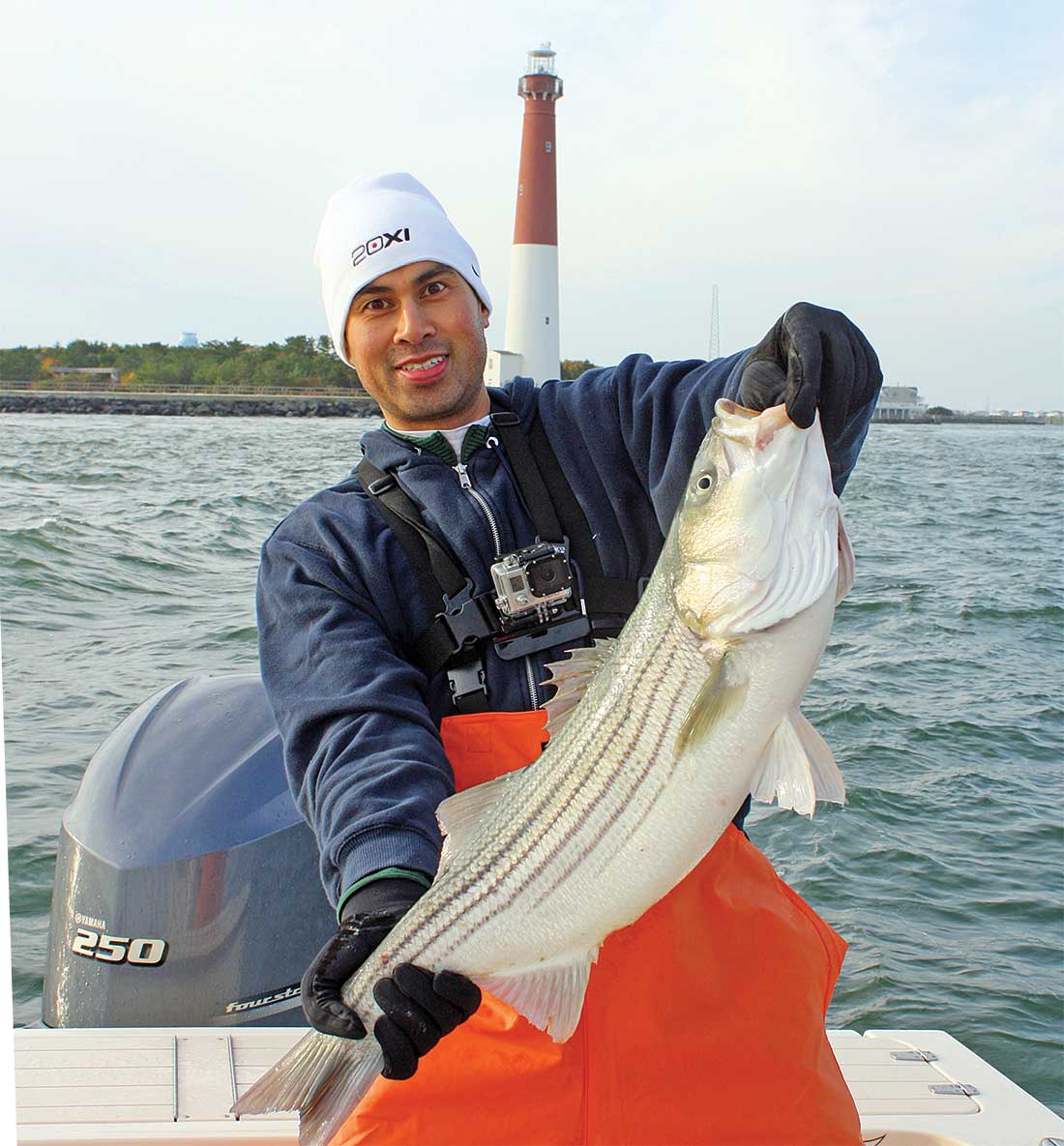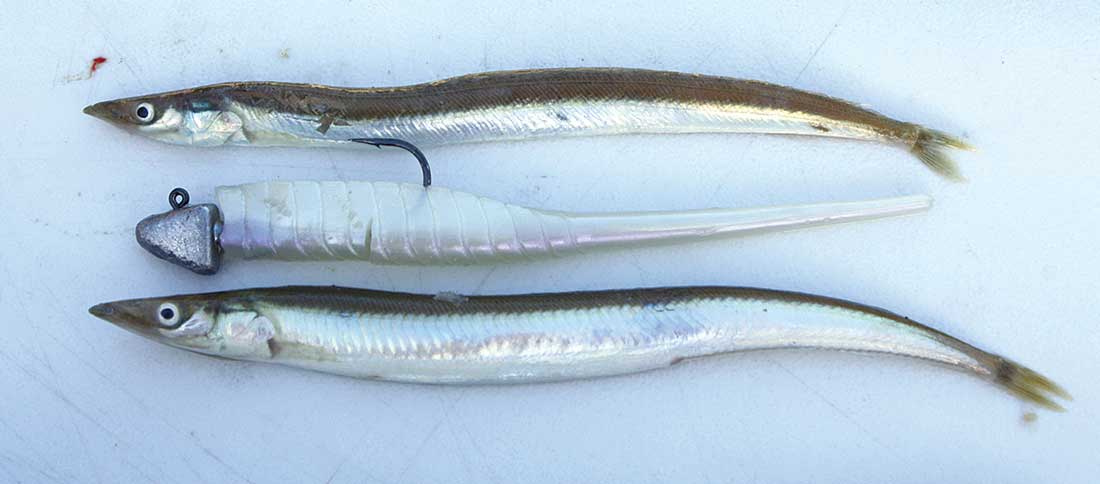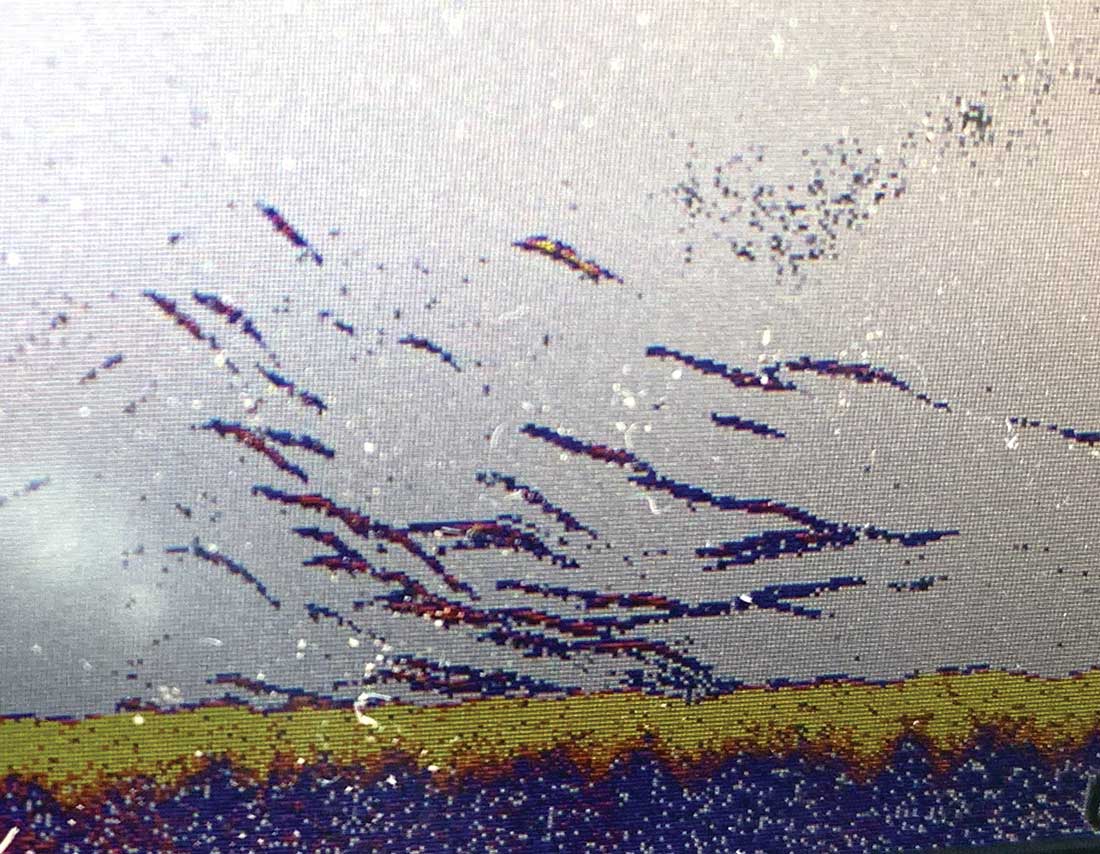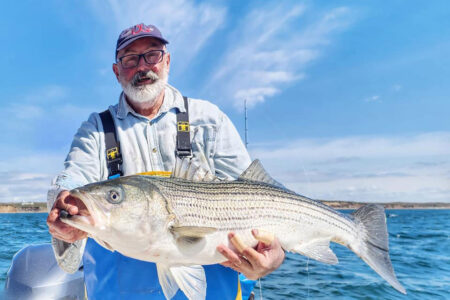Considerations for your seasonal menu when successfully targeting stripers
Whether you fish from the surf, ply the back bays, or hit the ocean for Atlantic striped bass, it’s important to find out where they’re dining and what’s on the menu. Predatory fish like striped bass will feed on a variety of baitfish, but profiling their most favorite prey items during certain parts of the season will help with lure selection.
Lure selection can be guided by a variety of factors including, but not limited to: color, size, profile, lure action, and environmental factors. Anglers that possess good background knowledge of the area’s baitfish population will be better apt to select the correct lures and presentations for each fishing situation. Before getting into the nuts and bolts of baitfish and lures, it is beneficial to understand the migration patterns of our coastal stripers.

The Coastal Migration
Striped bass is an economically important gamefish that migrates off the coast of New Jersey during April to June and again October through January. Their specific location and duration at each will vary; but it all depends on bay and ocean temperatures, coastal storms, and bait migrations. Striped bass migrate in a longitudinal pattern during the spring, and return the opposite direction in late fall. In addition to the energy expenditure of traveling, the spring drive to breed uses an additional amount of energy.
Early in the season as the water temperatures are hovering in the mid-40s to 50s, striped bass activity will be concentrated in the warmer bay waters. Once the ocean temperatures warm to the low to middle 50-degree temperatures, menhaden will start to become the main source of energy for migrating bass. Bass will feed aggressively post-spawn as they follow these schools of bunker northward.
Atlantic menhaden (brevoortia tyrannus) or bunker are extremely important species for a variety of marine wildlife from seabirds to fish to mammals, even humans. They are excellent filter feeders that swim in schools with their mouths open filtering plankton, algae, and other micro-invertebrates out of the water. Many species rely on this prolific baitfish during all points of their lifecycle from Florida to Nova Scotia.
Commercial bunker regulations are necessary as overfishing menhaden can severely impact a host of predators in the marine food web. There was an excellent book published years ago, The Most Important Fish in the Sea: Menhaden and America, by Bruce Franklin, which tells how this fish has shaped our country’s history.
– Capt. Brett Taylor.
As autumn arrives in the Northeast, the shallow angle of the sun causes bass to return on their southerly migration. After a month or two of leaving the waters of New England, the bass bite historically is in full swing off the coasts of New York and New Jersey. Heavy feeding occurs again as bass have to “fuel up” for the winter spent off the coasts of Virginia and North Carolina.
Although there may be slight variations, this cycle repeats itself year after year, and anglers pattern movements of stripers. When knowledge of baitfish is added to this equation, onwater success increases ten-fold. The main entree for each part of the season will always depend on the types of bait present and the populations will vary from season to season. Anglers should remember that fish are always looking for the easiest meal, which means most calories for the least amount of effort.
Early Season Appetizers
From late March through May as bays begin to warm, turbulent weather upturns clams, marine worms, and other crustaceans. Stripers in the back are apt to pick up these free, high-protein meals of bivalves and nematodes. With the water relatively cold, metabolism rates are slower so bass will often turn to these easily digestible meals that require minimal processing. Anglers plying the beaches when the water temperatures are cold will have their best bet fishing fresh clam baits as opposed to bunker chunks.
The bay temperatures can range from 10 to 20 degrees warmer depending upon the depths. This is why the backwaters are a great place to target bass in the beginning of the spring run. Clam baits, soft plastics mimicking small baitfish or worms are great choices when fishing the backwater estuaries. Another method that replicates one of their favorite early season baits is a drifted sandworm or bloodworm. Locations around sod banks, sedges, and mud flats will naturally have these types of marine organisms and are prime locations for drifting or working for land. They can easily be fished by placing two to three worms threaded onto a 1/0 to 2/0 baitholder hook that is snelled to a 3-foot leader followed by a slide sinker. Anglers may be surprised on the size of the early season striped bass swimming in the shallow mud flats as some can be in the 40-inch range.
A word or two on worms; they are a staple food source for many marine species as these are relatively easy to catch prey items that pack good sources of protein. Sandworms and bloodworms, both members of the genus Nereis, live in burrows in the mud and sandy bottoms. During times of the new moon, mating occurs near the surface with swarming male worms exhibiting their iridescent greenish-blue colors. Surface swarms or “worm hatches” make them easy prey for marine gamefish.
Mid-Season Entrees
As ocean temperatures begin to warm in late May through June, the presence of menhaden or bunker signals the dinner bell for migrating stripers. Warmer water temperatures, higher rates of metabolism, and calorie deprivation from the journey to spawn all factor in a changeover to these high fat-protein fish. Anglers livelining bunker, tossing bigger plugs, or deploying trolling gear will see a pattern of “on and off” feedings that are directly related to the digestion of these big baits. You can think of it as eating a big meal; your sense of hunger wanes as the body processes the consumed food. Many times bass will get finicky during this part of the season making the bite considerably more challenging.
Unfortunately, New Jersey anglers get an unwanted break during the summer as most of the migratory bass will have passed us. But schoolie stripers are in the bays and inlets for most of the summer, and can still be targeted with soft plastics and plugs. One trick from “striped bass sharpies” is to fish during a few days of a hard summertime south wind. Southerly winds will chill the waters down and bass will generally be feeding around the inlets on the colder incoming tide. Last year, we had striped bass during the end of July aggressively feeding on small Tsunami swim shads and jerk shads during the morning incoming. The bite only lasted for two days, which was directly caused by a period of south winds.

Late Season Desserts
November, December and sometimes into January will signal a host of baits, but the sand eel can be one of the most prominent ones especially from New York to New Jersey. Sand eels are another schooling fish that are food sources for a variety of gamefish and seabirds. These small 4- to 7-inch eels will use the sand as cover and will swim as large schools. Predatory fish will ambush them from the bottom and pushed-up sand eels become easy pickings for a variety of seabirds.

Their official name is sand lance or lesser sand eel (ammodytes tobianus) which most anglers refer to as “sandeels” and there are several species that inhabit both coasts of the United States. Sand eels are a large part of the diet for many saltwater gamefish, marine mammals, and seabirds. Studies have shown that annual abundance of this species is highly variable and ultimately depends on survival of the juvenile class.
Anglers choosing narrow profiled soft plastic baits or slim jigs that resemble these sand eels will out-perform all others. Hogy jigs and soft plastics such as the Bass Kandy Delights make excellent sand eel impressions. Anglers preferring trolling should opt for umbrella rigs tied with small eel-like lures when this baitfish is present. The bite changes from day to day, but green, red, black, and even purple are good colors to have on-board.
By the middle of this month, one of the very best striped bass locations along the entire Striper Coast is along the Raritan Bay. Big, spawning class stripers will “stage” along the Raritan in the early part of April to feed before their trip up the Hudson River to spawn. Where these monster fish pop up is anyone’s best guess, but expect crowded parking lots by land and by water when and where they do. Typically, SP Minnows, Mag Darters and varied wooden swimmers will get the job done by boat or by bank; with new striper regulations in effect as of April 1, anglers should consider swapping out trebles for siwash hooks to ensure proper release of the spawning fish. Also, use your gripping tool for in-water unhooking and release, not for vertical weights on the scale. Catch & release ‘em up!
– Jim Hutchinson, Jr.
Other baitfish that frequent the fall-run in various sizes are herring and menhaden. Tsunami wim shads or similar styled swim baits in the 4- to 6-inch sizes can be devastating on these bass. White, natural, or chartreuse are popular colors when menhaden or herring is present. Similarly, anglers preferring trolled lures should be using umbrella rigs with shads, mojos, or medium sized bunker spoons. Generally, the fall is the best in terms of quantity vs quality as these fish are aggressively moving and feeding in preparation for the upcoming winter.
Anglers looking to improve their fishing abilities should always be investigating information about both predator and prey. This information becomes indispensable, especially considering that saltwater fishing involves so many variables. When talking to anglers who are consistently successful, a common theme emerges, which is the vast knowledge on the targeted species and its prey.
Most “sharpies” will have a good idea of what a species is feeding on in a particular instant of time. By incorporating this into your fishing bag of tricks you can increase the overall angling enjoyment.




